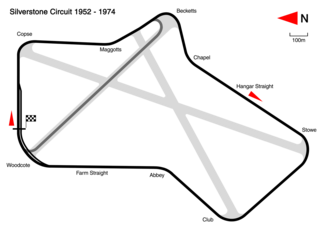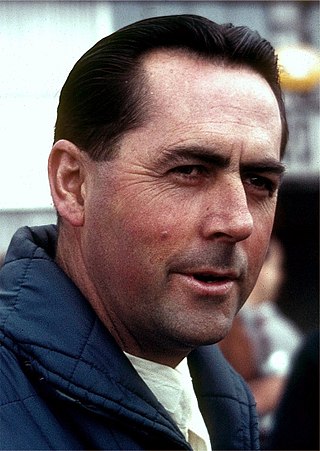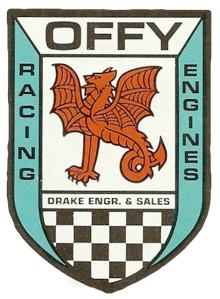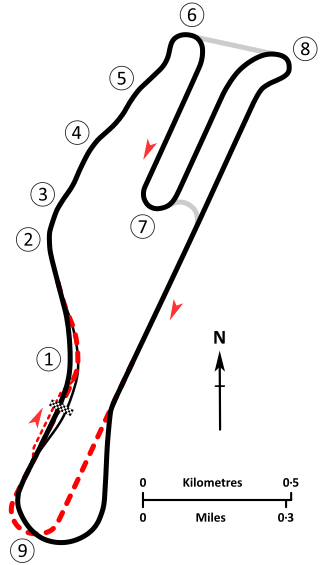
Anthony Joseph Foyt Jr. is an American retired auto racing driver who has raced in numerous genres of motorsports. His open wheel racing includes United States Automobile Club Champ cars, sprint cars, and midget cars. He raced stock cars in NASCAR and USAC. He won several major sports car racing events. He holds the USAC career wins record with 159 victories, and the American championship racing career wins record with 67.

Rodger Morris Ward was a World War II P-38 aviator in the United States Army Air Forces, and an American race driver with 26 victories in top echelon open-wheel racing in North America, two Indianapolis 500 victories, and two USAC National Championships, who conceived the classic tri-oval design and layout of Pocono International Raceway, modeled after his three favorite signature turns, at Trenton, Indianapolis and Milwaukee.

Lance Graf von Haugwitz-Hardenberg-Reventlow, was a British-born American entrepreneur, racing driver and heir to the Woolworth fortune. Reventlow was the only child of heiress Barbara Hutton and her second husband, Count Kurt Haugwitz-Hardenberg-Reventlow. His stepfathers included actor Cary Grant and Prince Igor Troubetzkoy.

The 1960 British Grand Prix was a Formula One motor race held at the Silverstone Circuit, Northamptonshire, England, on 16 July 1960. It was race 7 of 10 in the 1960 World Championship of Drivers and race 6 of 9 in the 1960 International Cup for Formula One Manufacturers. The race was won by reigning World Champion Jack Brabham and Innes Ireland finished in third place. Between the two, multiple motorcycle Grand Prix World Champion John Surtees took second place.

The 1960 Formula One season was the 14th season of the FIA's Formula One motor racing. It featured the 11th FIA World Championship of Drivers, the third International Cup for F1 Manufacturers and numerous non-championship Formula One races. The World Championship commenced on 7 February and ended on 20 November after ten races.

Repco is an Australian automotive engineering/retailer company. Its name is an abbreviation of Replacement Parts Company and was for many years known for reconditioning engines and for specialized manufacturing, for which they gained a high reputation. It is now best known as a retailer of spare parts and motor accessories.
Charles George Daigh was an American racing car driver. He broke into Grand Prix racing through Lance Reventlow's Scarab team, through the virtue of being one of the resident engineers. Born in Long Beach, California, he participated in six World Championship Formula One races, debuting on May 29, 1960, and scoring no championship points. He also participated in one non-Championship Formula One race.

The Offenhauser Racing Engine, or Offy, is a racing engine design that dominated American open wheel racing for more than 50 years and is still popular among vintage sprint and midget car racers.
Walter Edwin Hansgen was an American racecar driver. His motorsport career began as a road racing driver, he made his Grand Prix debut at 41 and he died aged 46, several days after crashing during testing for the 1966 24 Hours of Le Mans.
Bruce Kessler is an American racing driver and film and television director.
Chaparral Cars was a pioneering American automobile racing team and race car developer that engineered, built, and raced cars from 1963 through 1970. Founded in 1962 by American Formula One racers Hap Sharp and Jim Hall, it was named after the roadrunner, a fast-running ground cuckoo also known as a chaparral bird.

The Mercedes-Benz W196 was a Formula One racing car produced by Mercedes-Benz for the 1954 and 1955 F1 seasons. Successor to the W194, in the hands of Juan Manuel Fangio and Stirling Moss it won 9 of 12 races entered and captured the only two world championships in which it competed.

Garrie Clifford Cooper was the founder of the highly successful Elfin Sports Cars and a competitive racing driver in his own right, winning the 1968 Singapore Grand Prix, the 1968 Australian 1½ Litre Championship, and the 1975 Australian Sports Car Championship - all in Elfin cars of his own design.

Kaditcha was an automobile manufacturer in Australia. The company, formed by Queensland engineer Barry Lock, made open wheel and sports car racing cars, including cars for Formula 5000, Formula Pacific and Australian Formula 2.
The Matich name was applied to a series of sports racing cars and open wheel racing cars produced in Australia between 1967 and 1974 under the direction of Sydney-based racing driver and engineer Frank Matich.

The 1958 United States Grand Prix for Sports Cars was a sports car race held at Riverside International Raceway on October 12, 1958. It was the fourth and final round of the 1958 USAC Road Racing Championship season, the seventeenth round of the Sports Car Club of America's Pacific Coast Championship, the second running of the Riverside Grand Prix, and the first post-World War II running of the United States Grand Prix. The race was held over 62 laps of Riverside's 3.3-mile (5.3 km) circuit, for a total of 203.1 miles (326.9 km). Chuck Daigh won the race overall, driving one of Lance Reventlow's Scarab-Chevrolets. The race is also noteworthy in the annals of international racing, as the strong second-place finish by a local driver named Dan Gurney earned him a test drive in a factory Ferrari Formula 1 car, effectively launching the Californian's legendary racing career.
The Mildren name was used on a series of racing vehicles constructed for, or acquired by, Australian racing team owner Alec Mildren during the 1960s and early 1970s.

The Zerex Special was a sports racing car. Originally a Cooper T53 built for the 1961 United States Grand Prix, it was rebuilt for usage in American sports car racing, and featured open-top bodywork. Initially using a 2.75-litre version of the Coventry Climax FPF straight-four engine, it later used a Traco-Oldsmobile 3.5-litre V8. The car won numerous races throughout its four-year career, being driven by drivers such as McLaren and Roger Penske.

The Ferrari 412 S was a unique sports racing car produced by Ferrari in 1958. The 412 S combined Ferrari's most powerful V12 engine to date with a one-off experimental racing chassis. It was also incorrectly called as the 412 MI due to being built around an engine from the 500 Miles of Monza racer. The car was created specifically for John von Neumann to take on the American racing cars Scarabs in SCCA racing. Its famed drivers included Phil Hill and Richie Ginther.
Leo William Goossen was a draftsman, mechanical engineer and automobile designer. He is known for his work with Harry Miller and his long involvement in the design and ongoing development of the four-cylinder Offenhauser ("Offy") racing engine.
















